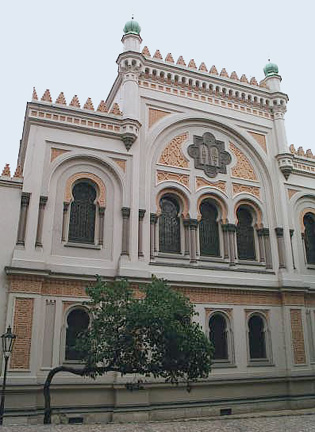The Spanish Synagogue
 The Spanish Synagogue
is the most beautiful one in Josefov
The Spanish Synagogue
is the most beautiful one in Josefov
The Spanish Synagogue is by far the most
spectacular of all the synagogues in Josefov and it was the last
one to be built in the old Jewish quarter. In 1998, the 130ieth
anniversary of its founding, it was reopened after over 20 years
of being closed to the public.
Construction on the building began in
1868 on the spot where the Alt Schul (Old School) once stood.
The Alt Schul was the oldest Jewish house of prayer in Prague
before it was torn down.
The Spanish Synagogue got its name because
the interior decor was inspired by that of the Alhambra, a building
in Granada, Spain that was built by the Moors. In 1492, the Moors
and the Jews were expelled from Spain, and the Jews scattered
to other countries in Europe. The Moors were Muslims, who were
followers of Mohammed and the Koran. One of the laws of the Koran
forbids any human figures or animal forms in sculpture or painting.
That is why Moorish architecture uses only geometric figures
in the interior decoration of a building.
The Spanish Synagogue is a mind-boggling
sight with its profusion of Moorish motifs of flowers and geometric
patterns in brilliant reds, blues and greens with gold trim.
The entire interior is covered with color on the ceiling and
the walls; the stained glass windows repeat the brilliant colors
and patterns. The windows and the interior were designed by architects
A. Baum and B. Münzberg; the work was completed in 1893,
the same year that the city decided to tear down the old ghetto.
The older synagogues in Europe typically
feature a bimah in the center of the room and benches around
the walls, but the Spanish Synagogue has benches arranged in
rows in the center of the room, just like in a Christian church.
All of the orthodox synagogues have a separate women's gallery
which is located above the main hall, like a balcony on three
sides of the room. The Spanish Synagogue has decorative cast
iron columns holding up the women's gallery. There is a display
of photographs in the women's gallery.
The Spanish Synagogue is located a couple
of blocks away from the Maisel Synagogue where I started my tour
of The Jewish Museum. It was my second stop on the tour because
the displays here are the second part of the exhibition called
"History of the Jews in Bohemia and Moravia from Emancipation
to the Present." This section covers the history of the
Czech Jewish community during the periods of enlightenment and
emancipation, the Austro-Hungarian Empire, the First Republic
from 1918 to 1938, the Nazi Protectorate of Bohemia and Moravia
from 1939 to 1945, and the post-war period.
|